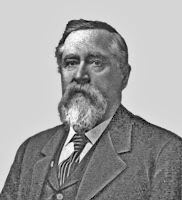 |
| Senator Pence. H. T. French photo. |
Pence briefly tried his hand at prospecting but soon turned back to freighting instead. For three years, he bullwhacked trains from Umatilla to Boise City, and sometimes on into Idaho city. He spent one season on a homestead in the Boise Valley, but then began driving a stagecoach that served the new gold camps in northern Nevada. Contacts there soon led to a blacksmith job at a camp ten miles or so south of the Idaho border.
The stage road from Nevada passed near where the Bruneau River joins the Snake, which led Arthur to explore that part of the country. Encouraged, in April 1869 he filed on some hot springs at the upper end of the Bruneau Valley - the springs still bear the name “Pence Hot Springs.”
Arthur and a brother ran cattle in the Bruneau area for about a decade. By then, Idaho stockmen were exporting tens of thousands of cattle out of state. The brothers may have decided the market was too glutted to be profitable, so they sold off their herds and went into vegetable farming. They did a fine business selling produce in the mining camps until about 1885.
 |
| Western sheep herding. Library of Congress. |
Pence helped organize the Bruneau State Bank in 1905, and also went into politics. He was elected to the state House of Representatives in 1901, and to the state Senate in 1903 and again in 1907. During his first term, the legislature authorized a reform school to be built in Fremont County. During the second, they funded the first fish hatchery created in the state. Pence helped create a school district in the Bruneau Valley and became almost a permanent member of the school board.
In 1911, Governor James H. Hawley [blog, January 17] appointed Pence to the state Livestock Sanitary Board. That board served to promote the livestock industry and to protect it from losses due to theft or disease. Thus, they appointed the State Veterinarian, approved the registry of purebred stock, compiled reports about infectious diseases, and much more. Pence spent six years on the board, part of that time as its president.
Arthur and his wife, the former Mary Sydney Wells, remained life-long fixtures in Bruneau society. According to local historian Adelaide Hawes, who knew them personally, Mrs. Pence was universally known as “Aunt Sydney.” Pence Hot Springs, which they left open to all, also became a social center. Hawes wrote, “Every Sunday from early morn till evening the people came.”
Arthur passed away in 1935 and Sydney three years later. They are interred in the Hot Springs Cemetery.
| References: [French], [Hawley] |
| Adelaide Hawes, Valley of Tall Grass, Caxton Printers, CaIdwell, Idaho (1950). |
| “[Pence News],” Idaho Statesman, Boise (January 8, 1911 – April 18, 1917). |